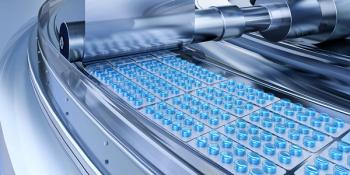
Equipment and Processing Report
- Equipment and Processing Report-11-19-2014
- Volume 0
- Issue 0
Using Robotics In Pharmaceutical Manufacturing
Robots are proving advantageous in filling, inspection, packaging, laboratories, and the manufacture of personalized medicine.
Automation, including automated inspection and packaging, is becoming an increasingly important part of pharmaceutical manufacturing. The many benefits of automation include efficiency, saving workers from hazardous environments or repetitive tasks, reducing training overhead, eliminating human error, increasing repeatability and reproducibility, and in cleanrooms, removing the potential for human contamination.
A robotic system is a type of automation that has multiple axes of motion and can be programmed to perform a function. Robot types include articulated, cartesian (i.e., gantry), parallel (i.e., delta), and selective compliance assembly robot arm (SCARA). Common applications include "pick and place" operations that often use SCARA robots. There is also a new, growing use of delta-type robots for high-speed picking and packaging, noted Chris Sumner, managing director of Fanuc Robotics UK and vice-president of Fanuc Europe Corporation, in a press release (1). Merck, for example, is using a Fanuc delta robot on a bottling line to place dispenser caps onto bottled allergy medications. "Ten variants of the bottle can be run on the system, and the only robot line-change requirement is to select the appropriate program on the robot controller," explained Sumner.
A study by the Association for Packaging and Processing Technologies (PMMI) found that robots are expected to handle 34% of primary pharmaceutical packaging operations in North America by 2018, compared with 21% in 2013 (2). An increase in the use of robots is seen in dispensing, sorting, kit assembly, and light machine-tending as well as in more traditional applications associated with packaging, notes Jonathan Ferrell, a packaging market manager at ABB Robotics. "The advantages of robotics are fairly simple: greater speed and accuracy, greater flexibility and reliability than hard automation, and they are becoming ever more affordable," says Ferrell.
Robots for filling, inspection, and packaging
Robotic technology is being used for vial-filling applications on slower speed applications. "Robotic vial manipulation transfers components from station to station both before and after filling and pack-off," says Walt Langosch, director of sales and marketing at ESS Technologies. The company also has experience with handling plastic and glass prefilled syringes in pre-process, buffering, and initial and end-of-line packaging. "Automated syringe assembly, inspection, and preparation for packaging is an ideal application for robotics," says Langosch. "The primary advantage in sterile environments is reduction of risk due to environmental contamination and contamination generated from human intervention during component transfer." In addition, productivity is increased because of the accuracy and efficiency of robots, which often perform at increased speeds and produce less scrap.
Automatic inspection, as part of a robotic system, has the advantage of enabling 100% part inspection. Vision-sensing technology can be used in pharmaceutical packaging to verify serialization numbers for compliance with track-and-trace regulations. "Robotic dexterity and accuracy combined with current and future optical technology and serialization software is the ideal technology for an automated solution," says Langosch.
An advance in vision sensors is color imaging, which, for example, allows systems to distinguish between bottle caps of different colors, noted PMMI in a trend report (3). Vision sensors have also led to advances in end-of-arm tooling design that improve the ability of robots to accurately identify and place objects.
Robots for producing personalized medicines
Custom automation and contract-manufacturing company Invetech recently partnered with biopharmaceutical company Argos Therapeutics to develop automated manufacturing systems based on Argos' Arcelis technology platform for personalized immunotherapies. "The Arcelis platform uses two, five-axis robotic arms in the production of the mRNA from a patient’s tumor, which is used as the antigen for loading into the dendritic cells produced in the cellular processing equipment," explains Richard Grant, director of cell therapy at Invetech. "The cellular equipment uses automation to manipulate the white blood cells throughout the manufacturing process to control their development and maturation into dendritic cells. These cells express the desired antigens, which when delivered to a patient, will trigger the patient’s immune system to produce killer T-cells that will target the metastatic tumors."
"The RNA robots manipulate closed disposables to perform the process within the common Class 100,000 cleanroom space," says Grant. "The use of the closed disposables allows multiple patients' materials to be processed in the same manufacturing space, driving the facility capital and operating costs down significantly."
Argos' lead candidate is currently in Phase III clinical trials, and the automated technology is designed to be modular and easily scalable. Clinical processes are generally manual, skill-based processes that cannot operate practically or economically at commercial scale, notes Grant. Use of robotics, however, allows the processes to be scaled up commercially. "In addition, robotics allows new sites to be replicated around the world in a scale-out model, with minimum training for set-up and validation of new sites and minimal site-to-site variability in production processes," explains Grant.
Cleanroom robots
Robotic technology is ideal for cleanroom processes, such as aseptic filling, because it eliminates human contamination risk. Robotics can provide an ISO 5 environment to preclude the possibility of microbial ingress, says Langosch. ESS Technologies partners with Fanuc Robotics for secondary packaging and palletizing of pharmaceuticals, and Fanuc has several robots that will operate in an ISO 5 environment. The Fanuc M-430iA/2PV can withstand hydrogen peroxide vapor sterilization and has a waterproof rating; all wiring and cabling is routed through the robot’s hollow arm.
Robots designed for use in cleanrooms must minimize particulate generation to maintain cleanroom classifications, typically ISO Class 5 or 6. Cleanability, including minimizing crevices and ensuring the robot is resistant to cleaning and sterilizing agents, is also a requirement, notes Grant. Operator safety must be ensured by guarding or containing the robot. Another requirement is controlling the speed of robot movement to minimize impact on airflow and particle generation and to a lesser extent, managing heat generation and its impact on the heating, ventilation, and air-conditioning system of the cleanroom, explains Grant.
Robots in the laboratory
Robotics has come a long way in the pharmaceutical laboratory, notes Mike Ouren, Life Sciences manager at Precise Automation. In the laboratory, robots are used, for example, to transport microtiter plates between instruments. "Although the instruments can be loaded manually, a robot tied to a scheduling software system eliminates human error, maintains the quality of the experiment, and allows scientists to focus on the content of the experiment, instead of how they will execute it," explains Ouren.
Laboratories differ from industrial applications in that, although tasks are repetitive, they are not as consistent and may change depending on the experiment, says Precise Automation's Ouren. The need to access equipment near the robot quickly and the space limitations of a laboratory can be met with new collaborative robots that do not require safety guarding. In 2012, Precise Automation introduced a collaborative SCARA robot (or "cobot"), the PreciseFlex (PF)400, which handles less than 1-kg loads and is designed to allow operators to work safely next to the robot without barriers. The smaller footprint of the robot reduces cost, and the space savings is useful in benchtop laboratory applications. The robot is user friendly, and the Precise Guidance Controller inside the PF400 allows laboratory personnel to "teach" the robot using only their hands. "Because there are no barriers, instead of using a complex remote-control pendant to teach the robot, the operator can show the robot what to do by simply grasping the end of the robot arm. This accessibility is unheard of in industrial automation," explains Ouren.
Other laboratory applications for robots include vial handling. A Fanuc robot is being used in a laboratory, for example, as a single-point handling solution for vial processing. "A handling tool was designed and attached to the end of the robot to enable it to handle ten vials at a time. A variety of components were also placed around the robot cell-including indexing tables for full rack staging, a thermostatically controlled water bath for precise sample temperature, a retrieval system for dumped vials, a washing-brushing-rinsing-drying station, a preservative spray station, and a recapping station," explained Sumner in a press release.
In the laboratory and on the manufacturing floor, robots are increasingly used to improve quality and efficiency.
References
- Fanuc Robotics, "
A Bright Future for Robotics ," Press Release, March 2014. - PMMI, "
PMMI Talks North American Pharmaceutical Trends at interpack ," Press Release, May 8, 2014. - PMMI Packaging Intelligence Brief, "Trends in Robotics: Market Assessment, April 2014,"
www.pmmi.org/files/Research/2014RoboticsPIB.pdf , accessed Nov. 11, 2014.
Articles in this issue
about 11 years ago
Child-Resistant Packaging Meets Regulations and Consumer Needsabout 11 years ago
Eliminating Tablet Spots and Specksabout 11 years ago
Robotic Dispensing System Assures Repeatabilityabout 11 years ago
Automated Punch Polisher Increases CapacityNewsletter
Get the essential updates shaping the future of pharma manufacturing and compliance—subscribe today to Pharmaceutical Technology and never miss a breakthrough.





